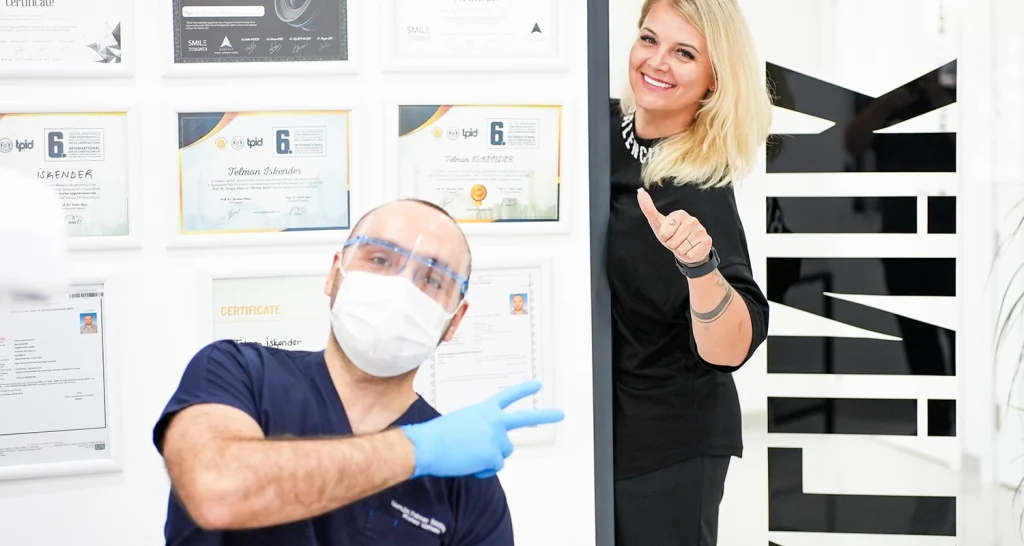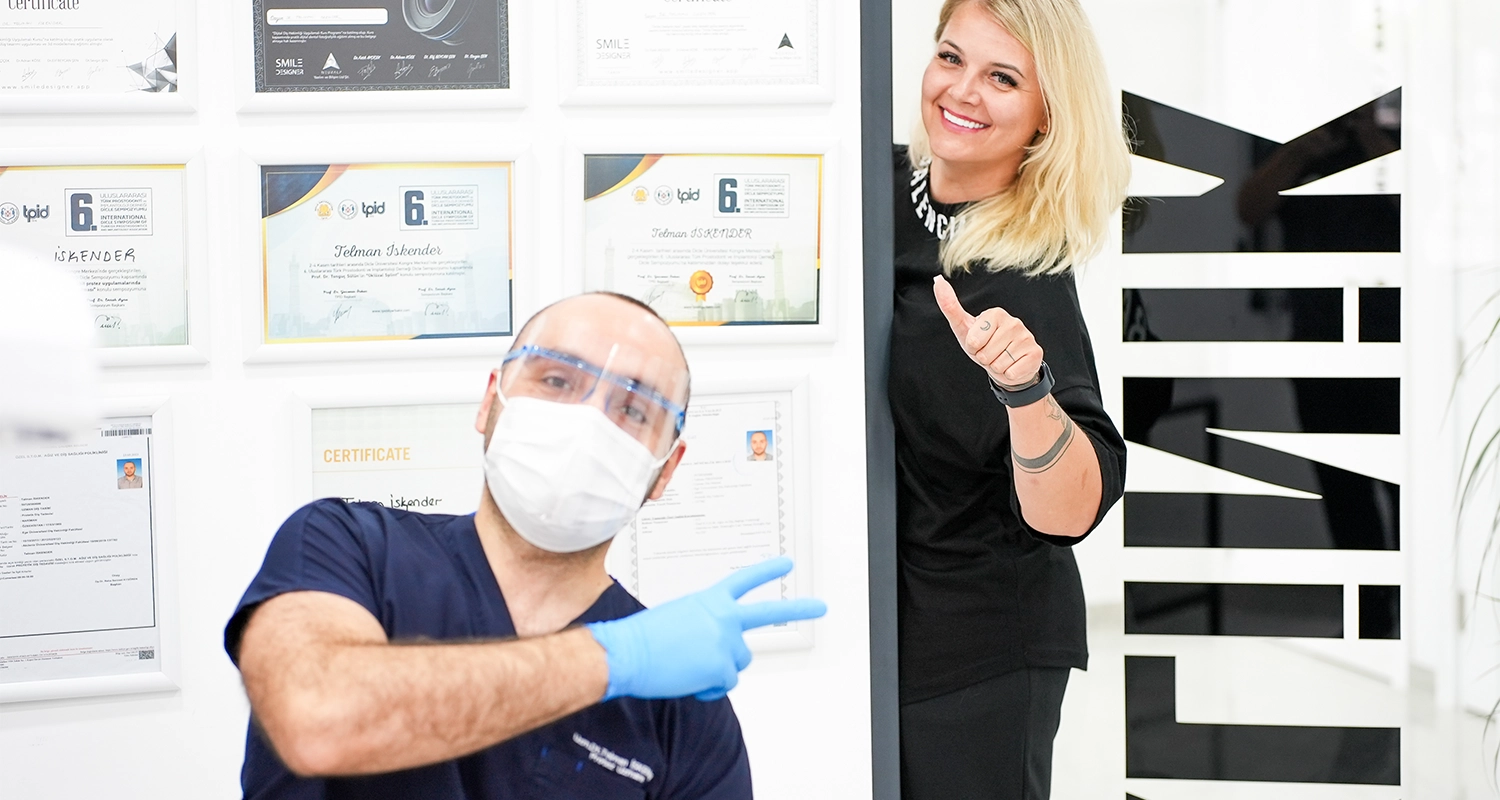Open or Closed Sinus Lift
Sinus Lifting: Healthy Implant Infrastructure
What is Sinus Lifting?
Sinus lifting is a surgical procedure aimed at creating the necessary amount of bone in the jawbone for implant placement. This specialised method offers a solution for patients with bone deficiency in the upper posterior tooth regions.

How to Apply?
Sinus lifting is usually performed with two basic methods, open and closed.
Importance of Sinus Lifting Before Implant
- Bone Insufficiency and Implant Success
Sinus lifting increases the success rate in cases where the jawbone is insufficient before implant placement.
- Aesthetic and Functional Gains
Sinus lifting supports aesthetic and functional improvement by preserving the patient’s natural tooth structure.
Open Sinus Lifting: An Effective Method to Increase Insufficient Bone Volume
What is Open Sinus Lifting?
Open sinus lifting is a surgical procedure that intervenes in the maxillary sinus cavity to create the necessary bone volume for implant placement. This method offers a solution for patients with bone deficiency in the area where the implant will be placed.
How is Open Sinus Lifting Applied?
- Pre-Operation Planning
A treatment plan is created with patient examination and diagnostic imaging.
- Surgical Procedure
The surgical field is prepared under local anaesthesia.
Access to the sinus membrane is provided by opening a window on the jawbone.
- Bone Graft Application
A special bone graft (usually from the patient’s own bone tissue or synthetic materials) is inserted into the sinus cavity.
- Removing Stitches
After the procedure, the surgical area is closed and sutured.
Advantages and Disadvantages of Open Sinus Lifting
Advantages
- More Bone Volume:
- By removing the sinus membrane, additional bone volume is created.
- Improving Implant Success:
- It increases implant success by creating a healthier implant infrastructure.
Disadvantages
Long healing process
Open sinus lifting may require a longer recovery period due to the nature of the surgical intervention.
- A More Invasive Method
It may be more invasive than other sinus lifting methods.
Open sinus lifting is an effective option to improve the success of implant treatment in cases of insufficient bone volume. However, the treatment plan should be created by taking into account the general health status and preferences of the patient. Our expert team offers the best treatment to our patients at every stage with a patient-oriented approach.
Closed Sinus Lifting: Healthy Implant Infrastructure with Minimally Invasive Method
What is Closed Sinus Lifting?
Closed sinus lifting is a minimally invasive surgical procedure aimed at filling the sinus cavity for implant placement. This method offers a solution to patients with bone deficiency in the posterior tooth regions of the upper jaw, but prefer a less invasive approach.
How is Closed Sinus Lifting Applied?
- A Small Incision
A small incision is made under local anaesthesia.
- Gently lifting the sinus membrane
Using special instruments, the sinus membrane is gently lifted, but not completely opened.
- Bone Graft Placement
A bone graft (the patient’s own bone tissue or synthetic materials) is placed into the sinus cavity.
- Implant Placement
After sufficient bone volume is created, the implant is placed.
Closed Sinus Lifting Advantages and Disadvantages
Advantages
- Faster Recovery Process
Closed sinus lifting usually requires a shorter recovery period because it is more minimally invasive.
- Less Invasive
Since it is performed through a small incision, it is less invasive than other methods.
Disadvantages
- Limited Bone Volume Increase
It can provide a more limited bone volume increase compared to open methods.
- Subject to Certain Conditions:
Its applicability depends on the patient’s bone condition and general state of health.
Closed sinus lifting is an effective method that allows patients to reach implant treatment with a faster healing process and a minimally invasive experience. However, each patient should be evaluated individually and the treatment plan should be carefully created by specialists.

In which cases is it applied?
Who is Open and Closed Sinus Lifting Suitable for?
Sinus lifting procedures are generally suitable for patients who have bone deficiency in the upper posterior tooth area and are considering implant treatment. Which method is preferred depends on factors such as the patient’s general health status, bone structure and suitability for surgery.
Open Sinus Lifting
- Dense Sinus Membrane
It may be more effective in cases where the sinus membrane is dense.
- The Need for Further Bone Increase
It can be preferred in cases where more bone volume increase is required.
Closed Sinus Lifting
- Minimally Invasive Preference
It may be suitable for patients who want a minimally invasive approach.
- Need for Rapid Recovery
It can be preferred in patients who want a faster healing process.
Diagnostic Imaging and Hospital Selection
A detailed diagnostic evaluation should be performed before each sinus lifting procedure. At this stage, imaging techniques such as digital X-rays and computed tomography are used to evaluate bone structure, sinus condition and general oral health.
The choice of hospital is also important. A dental clinic with modern technology and an experienced team is the key to a successful sinus lifting procedure. A suitable hospital should be selected by considering the patient’s comfort, treatment results and safety.
Each patient should be evaluated individually and the treatment plan should be carefully created by specialised dentists. A detailed consultation and evaluation process before the sinus lifting procedure ensures that the most effective treatment plan suitable for the patient’s needs is determined.
Post-Operative Care: Healthy Recovery and Patient Comfort
Recovery Process and Controls
The healing process that starts after sinus lifting operation may vary depending on the general health status of the patient, the method used and the graft material applied. The healing process includes the following steps:
First Week
In the first few days after the operation, it is important for the patient to rest and avoid heavy activities.
Control appointments are followed up regularly.
First Month
Swelling and bruising usually decrease after the first week.
It is important for the patient to pay attention to oral hygiene and maintain oral care as recommended by the doctor.
First Three Months
The process of bone graft integration and bone formation continues.
The implant placement process can be planned.
Six Months and After
After the implant is placed, the implant is expected to integrate with the bone.
Full recovery usually takes between six months and one year.
Pain Control and Other Healing Processes
Pain Control
Postoperative pain is usually mild to moderate. Painkillers prescribed by the doctor can be used.
Cold Application
A cold compress can reduce swelling and relieve pain.
Rest and careful nutrition
Rest and a soft, healthy diet are important in the first few days.
Complications and Precautions
Infection
During the healing process, it is important to take the antibiotics recommended by the doctor regularly against the risk of infection.
Swelling and Bruises
It is possible to reduce swelling and bruising with cold application and rest.
Graft Related Problems
It is important to follow the doctor’s recommendations for proper integration and placement of the graft material.
Post-operative care is critical to support the patient’s healthy recovery process. The patient can support a healthy recovery process by following the doctor’s instructions, following regular check-ups and contacting the doctor immediately in case of any concerns.
Healthy Implant Infrastructure and Smile Aesthetics
Sinus lifting is an effective surgical intervention that significantly improves smile aesthetics by creating a healthy implant substructure for patients with bone deficiency in the upper posterior tooth region. This procedure can improve the success of implant treatment by providing patients with a more solid foundation and help them achieve aesthetically satisfying results.
Healthy Implant Infrastructure and Smile Aesthetics
The healthy implant infrastructure obtained with sinus lifting operation brings many advantages:
Strong and Durable Implants
Increasing the bone volume allows the implants to be placed more firmly.
Aesthetic Developments
Implants provide a natural smile aesthetics by eliminating tooth deficiency.
Functional Improvement
A healthy implant framework improves chewing function and supports the oral structure.
Long Term Results
The healthy implant infrastructure created with the sinus lifting operation ensures long-term success and satisfaction.
Step into a Healthy Smile with Sinus Lifting
Sinus lifting operation allows patients to have a healthy smile by creating a bone base suitable for dental implants. Thanks to this treatment, patients with bone deficiency problems in the upper back tooth area can have a natural and aesthetic smile.
It is important to make a detailed evaluation before the sinus lifting procedure and to create a treatment plan suitable for the general health status and special needs of the patient. This operation, performed by specialist dentists, is supported by modern technology and surgical skill to maximise patient satisfaction. Sinus lifting is a reliable solution to step into a healthy smile.

